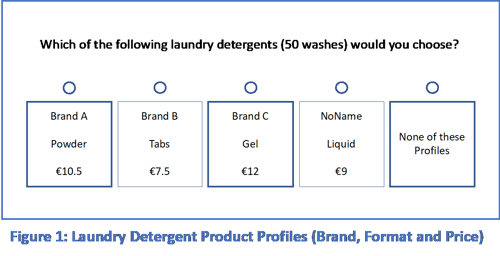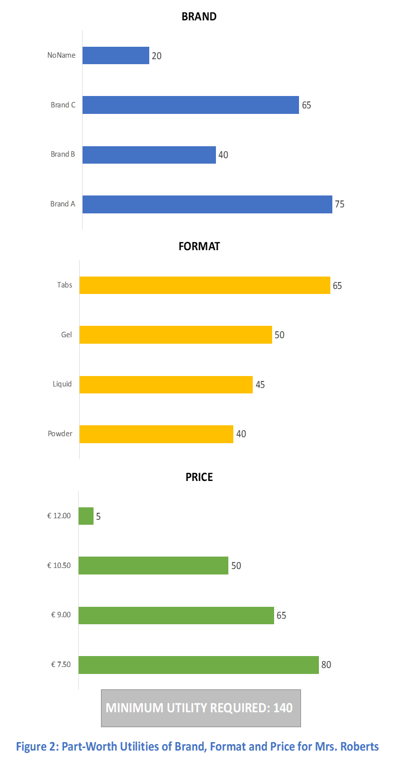Price Premium - An Indicator of Brand Strength
 Dr. Oliver Koll
·
5 minute read
Dr. Oliver Koll
·
5 minute read

Guest author: Univ.-Prof. Dr. Oliver Koll, Professor of Marketing and Partner at IMARK Strategy Consulting
What is a Price Premium?
There are a number of different metrics one can use to evaluate brand strength. Brand recognition, likeability, willingness to recommend, readiness to purchase are some of the most popular ones. A number of studies have shown, that these cognitive and affective factors are also linked with the consumers’ willingness to pay for a brand’s products. The more appealing a brand, the more the consumer is typically willing to pay for its products. Therefore, a comparison of the willingness to pay for a brand with relevant references products or “NoName” competitors provides insights into a company’s brand strength.
A brief example:
Mrs. Roberts is doing her weekly shop and needs amongst other things, a box of laundry detergent. She prefers lavender scented, washing-liquid. There are 3 options for her to choose from in the store. Brand A and Brand B for €9 and a no-name for €7.50. As Mrs. Roberts recognises Brand A and has had good prior experiences with its product, she chooses Brand A.
Mrs. Roberts has the choice between 3 comparable products. The product of brand A is appealing enough, that she selects it over the €1.50 cheaper NoName product and the equally expensive Brand B product. Brand A may even be able to increase its prices further, before Mrs. Roberts would switch her choice to a different product. This higher willingness to pay reflects the greater value that Brand A offers Mrs. Roberts relative to the other competitors.
Calculation of Price Premium
In setting its prices, a company could rely on its previous experiences or ask customers directly: “How much more expensive than a NoName product could our brand’s laundry detergent be?” or “How much would you be willing to pay for a specific product feature?”. However, the validity of these responses would be questionable. Alternatively, experiments could be conducted. The Laundry detergent producer could test different prices in different regions, she could change the price and wait and see how many customers she gains/loses. She could simply set a similar price to that of her competitors. Such trial and error methods are however suboptimal, as mistakes made are detrimental to the producer’s earning.
A market research technique, which is particularly well-suited for determining these price premia is conjoint analysis. This technique centres around the assumption, that individuals think of products and services in terms of their attributes/features and select those whose combination of features provide them with the highest utility. This means that consumers are willing to compromise on the combination of features in order to maximise their utility.
In an ideal world, most consumers would prefer a car which offered great performance, appealing design, lots of space, great fuel-efficiency and a low price. However, this combination is technically and commercially not viable. This is why car manufacturers offer customers the choice between different models, that vary greatly in their combination of features. These combinations of features (e.g. a sports car with high fuel consumption and price, hatchback with bland design and low price) are then appealing to the consumers, who derive the most value from the combination possessed by the model.
Understanding which features provide the most utility for which customers is the foundation of any behavioural segmentation strategy and the focus of conjoint analysis. In the conjoint survey, respondents must choose between several product profiles, which differ in their combination of features and the level of those features (e.g. price, laundry detergent type). Through repeated choices amongst many different profiles, one is able to determine which product attributes are truly important in the purchase decision and what prices consumers are willing to pay for the different attributes and their respective levels.
The advantage of this method is that choices are made by comparing several product profiles (conjoint = joint together). This more closely resembles how consumers make purchase decisions in reality rather than evaluating the importance of attributes and the respective willingness to pay for them individually.
 Consider the previously mentioned laundry detergent example: The producer of brand A knows that brand, price and format (powder, liquid, tabs or gel) of the laundry detergent are important decision criteria for consumers.
Consider the previously mentioned laundry detergent example: The producer of brand A knows that brand, price and format (powder, liquid, tabs or gel) of the laundry detergent are important decision criteria for consumers.
By analysing product profile choice decisions like the one seen in Figure 1, individual part-worth utilities of each attribute can be determined for every respondent, which indicate the relative importance of different attributes. Furthermore, it also shows us how non-preferred attribute levels can be compensated by other attributes for each respondent. Through this analysis, individual respondents are then able to be placed in customer segments (e.g. loyal customers, powder purists, clients of a specific supermarket).
In figure 2, we see the part-worth utilities, determined by Mrs. Roberts product profile choices. They show that she prefers cheaper detergents relative to expensive ones. She also finds tabs more attractive to other detergent formats and prefers Brand A and C over Brand B and the NoName.
 The difference in part-worth utilities of the different attribute levels reveal that her preference of Brand A over the NoName is stronger relative to her preference of tabs over detergent powder. Accordingly, she would only choose a tab-format NoName detergent (sum of part-worth utilities: 85) over powder Brand A detergent (sum of utilities: 115) if it was considerably cheaper. But how much cheaper?
The difference in part-worth utilities of the different attribute levels reveal that her preference of Brand A over the NoName is stronger relative to her preference of tabs over detergent powder. Accordingly, she would only choose a tab-format NoName detergent (sum of part-worth utilities: 85) over powder Brand A detergent (sum of utilities: 115) if it was considerably cheaper. But how much cheaper?
If Brand A offered its powder detergent for €10.50 (sum of utilities: 165), the no-name brands tabs would have to be at least €3 cheaper for them to be chosen by Mrs. Roberts. This is because at a price of €7.50, the sum of the utilities of the NoName tabs would also be 165, making Mrs. Roberts indifferent between both choices.
If Brand A offered its powder detergent for €12 (sum of utilities: 120), then a price difference of just €1 would be sufficient. Here the Noname product price needs to compensate for the difference between 120 and 85 (=35) utility points. This compensation corresponds to a price of roughly €11 (assuming a linear relationship between the price levels).
Calculating Brand Value
Determining the value of one’s own brand, sometimes through relevant rankings, is an important concern for many corporations. That being said, a brand value of for example €150 million is an abstract figure and heavily influenced by current developments and financial markets. Brand value can be made a much more concrete concept, when framed as a specific willingness to pay. How much more are consumers willing to pay for your product relative to that of your competitors? In other words: What is the premium, that consumers associate to my brand’s products?
Two alternative approaches exist:
Willingness-to-Pay
The addition of a “none of the profiles” option to choose from in the conjoint survey allows us to determine the minimum utility a product profile needs to provide in order to be selected over the no-choice option. This value (140 for Mrs. Roberts) can then be used to determine the willingness to pay for different attribute combinations.
For example, Brand A could charge a price of €11 for its powder detergent (sum of utilities: 115), in order to meet the minimum utility requirement of 140 utility points to be selected. In tab-format (Sum of utilities: 140), this price is €12. The potential revenue of different price points (as well as an evaluation of the costs for the company of offering this product profile) helps the management of Brand A to make informed decisions regarding the implementation of tab detergents.
Price Premium
For the calculation of the Price Premium, we increase the price of a brand’s products, until it is equally as appealing as those of its competitors. This premium can of course also be negative (The competitor is more attractive when both product prices are equal).
In the above example, the difference between the part-worth utilities of the different brands is 55 between Brand A and the NoName and 20 between Brand B and the NoName. If the NoName detergent is sold for €7.50 and in the same format as brand A (Sum of utilities: 100), then the price premium of brand A over the Noname is approximately €4 and roughly €2 over brand B. At a price of €11.50, Brand A would provide Mrs. Roberts with an equal amount of utility as the NoName. With respect to brand B, this price point would be approximately €9.50.
This method allows for the regular re-evaluation of one’s own price levels (in different regions, across channels, or segments), whilst also providing an easily interpretable figure for brand strength which can be tracked over time. Combining the conjoint results with other important brand drivers (e.g. degree of innovation, sustainability, etc.), it is also possible to determine the most salient influencing factors of market prices.
.png?width=400&height=100&name=PBLogoTransparent%20(1).png)



